Is it safe to use in a microwave? Microwaves are a staple in modern kitchens for quick heating, but not all containers are microwave-safe. Knowing which materials are safe is essential to prevent hazards and ensure food safety. Manufacturers rigorously evaluate plastic products designed for food storage and reheating to ensure various critical factors:
- Food Freshness: These containers must effectively preserve the freshness of the food, preventing spoilage and maintaining the quality for as long as possible.
- Taste and Safety: These containers should not impart any unwanted flavors or odors to the food, nor should they compromise food safety. This involves assessing the plastic materials for harmful chemicals leaching into the food.
- Durability: These containers should withstand the wear and tear of daily usage, including resistance to scratches, impacts, and temperature changes. This ensures that the storage products remain functional and safe over time, even with repeated use in various conditions.
Understanding Microwave Safety
Is a microwave safe? This is a common question among users of this handy kitchen appliance. To answer this and similar inquiries, this guide will explore various aspects of microwave safety. We will cover microwave oven features, selecting appropriate materials, cooking tips, health considerations, and maintenance advice. Let’s dive into these details to ensure your microwave cooking is both safe and efficient!
- Microwave radiation is non-ionizing, which means it doesn’t have the ability to ionize atoms or molecules, unlike X-rays or gamma rays.
- Follow our expert recommendations for safe operation and maintenance of your microwave.
- If you experience any issues, its time to repair your microwave and ensure it continues to operate safely.
Microwaves utilize electromagnetic waves to heat food efficiently. However, certain materials can react negatively in the microwave, leading to issues such as sparking, melting, or even releasing harmful toxins. For instance,
- Metals can cause arcing
- Some plastics may warp or leach chemicals into your food when heated
To mitigate these risks, it’s essential to use microwave-safe containers specifically designed for this purpose. These containers are made from materials that can withstand microwave radiation without reacting adversely. By choosing the right containers, you can ensure safe and effective heating of your meals while avoiding potential hazards.
Materials Commonly Used in Microwaves
Microwave-Safe Containers
When it comes to microwaving food, selecting the right containers is crucial for safety.
Glass, ceramic, and certain types of plastics are typically considered safe for microwave use, especially if they carry a microwave-safe label.
These materials are designed to withstand the heat generated during cooking without breaking down or leaching harmful substances into your food.
Always look for containers explicitly marked as microwave-safe to ensure they can handle microwave temperatures effectively.
Unsafe Materials
On the other hand, some materials should be avoided in the microwave due to safety concerns.
- Metals and aluminum foil can cause sparks or arcing, which not only damage the microwave but may also present fire hazards.
- Additionally, certain plastics can warp, melt, or release toxic chemicals when heated.
It’s essential to read labels and check for any warnings on containers before using them in the microwave. By being mindful of your choices, you can prevent accidents and ensure a safer cooking experience.
Common Symbols to look for
Microwave Safe Symbols
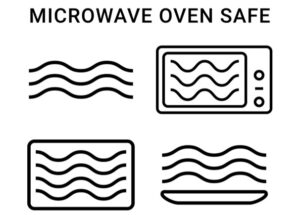
Many plastic wraps, packages, and containers are specifically designed to endure microwave temperatures. They undergo testing at elevated temperatures to ensure stability during and after microwave use. The same rigorous testing applies to products intended for freezing or dishwasher use. To help the consumers identify whether a plastic storage product is microwavable, dishwasher-safe, or even freezable, the labels or containers often display specific symbols. Here are some common symbols to look for:
Three Wavy Lines (Most commonly used variation)
The most common symbol for microwave safety features three wavy lines stacked neatly on top of one another. These lines resemble radio waves, subtly nodding to the technology that powers microwaves and heat food. This symbol removes the language barriers, acting as a universally recognized indicator of microwave compatibility. When the consumers see this symbol on a plastic wrap, container, or package it indicates that it is safe for use in a microwave. This clarity helps ensure food safety and convenience while allowing the user to heat their meals without concern for harmful reactions or damage to the container.
Microwave Icon with wavy lines
Manufacturers often enhance clarity by combining the classic trio of wavy lines with a miniature microwave oven icon. This variation reinforces the message of microwave safety and caters to individuals who may not be familiar with the standalone wavy lines. By incorporating both symbols, manufacturers create a clear visual representation that leaves no room for misinterpretation. This dual-symbol approach ensures that consumers can easily identify products that are safe for microwave use, promoting their confidence in their food preparation choices.
Freezer Safe
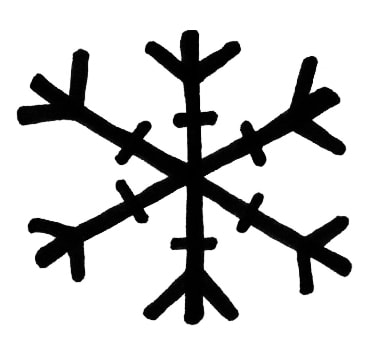
Typically, the “freezer safe” symbol is represented by a snowflake symbol. This symbol indicates that the plastic storage product can withstand low temperatures without becoming brittle or cracking, making it suitable for storage in a freezer. Products marked with this symbol are tested to confirm they maintain their structural integrity at freezing temperatures. These containers are designed to handle the expansion of liquids as they freeze, reducing the risk of breakage. Look for this symbol on containers, bags, and wraps intended for long-term food storage in the freezer.
Dishwasher safe
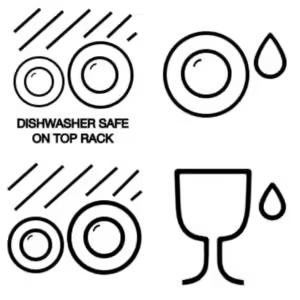
It often features a stylized image of a dishwasher, accompanied by water droplets or waves to signify washing action. This symbol indicates that a plastic product can be safely cleaned in a dishwasher without degrading or losing its functionality. Products marked with this symbol are specifically designed to withstand the heat and moisture of a dishwasher cycle, ensuring they won’t warp, crack, or become damaged. While many plastics carry the “dishwasher safe” label, it’s crucial to verify whether they are suitable for both the top and bottom racks. Some materials may only be safe in the lower heat areas, so checking the manufacturer’s guidelines is always advisable.
BPA-Free
BPA-Free indicates that a product does not contain bisphenol A (BPA), a chemical commonly used in the production of certain plastics. BPA has raised health concerns due to its potential effects on human health, particularly regarding hormonal disruptions. Products labeled as BPA-free are safer for storing food and beverages, particularly for items meant for children and infants. BPA-free plastics use alternative compounds with less hormonal activity, but not all substitutes are safe. Look for the BPA-free label on a variety of products, including food containers, water bottles, and baby products, to ensure they are free from this controversial chemical.
Types of Containers and Their Safety
Glass Containers
Heat-resistant glass, such as borosilicate glass, is an excellent choice for microwave use. This type of glass is designed to withstand high temperatures without cracking or shattering, making it ideal for heating food in the microwave. Always ensure that the glass containers you choose are labeled as microwave-safe to guarantee their durability during heating.
Plastic Containers
When selecting plastic containers for the microwave, it’s critical to use only those marked as microwave-safe. These containers are specifically designed to endure the heat generated in the microwave without warping or leaching harmful substances into your food. Additionally, steer clear of plastics that contain BPA (bisphenol A), a chemical that can pose health risks when heated.
Ceramic and Stoneware
Ceramic and stoneware containers are generally safe for microwave use, but caution is advised. While most ceramics are microwave-friendly, some may have glazes that contain harmful substances. Always check for microwave-safe labels, and if you’re unsure, consult the manufacturer to ensure the safety of the materials used in the glaze.
Paper Products
Many paper products, such as paper towels, plates, and bags, can be safely used in the microwave. However, it’s important to avoid printed or colored paper products, as the inks and dyes may contain chemicals that can leach into food when heated. To be safe, stick to plain, unprinted paper products that are designated as microwave-safe. This way, you can enjoy the convenience of using paper without compromising your health or safety.
Common Microwave Myths
Addressing common misconceptions about microwave safety is essential for promoting safe cooking practices. For instance, the belief that “all plastics are safe” can lead to hazardous situations. In reality, not all plastic containers are suitable for microwave use; only those specifically labeled as microwave-safe have been tested and deemed safe for heating. This distinction is crucial, as using the wrong type of plastic can result in melting or leaching harmful chemicals into your food.
It’s important to understand that “microwave-safe” does not equate to “oven-safe“.
Many materials that can withstand microwave radiation may not be able to endure the higher temperatures produced by conventional ovens. For example, certain plastics may warp in an oven, while some glass or ceramic dishes might crack under intense heat. By clarifying these myths, we can help ensure that users make informed choices, leading to safer and more efficient cooking practices in the microwave.
Best Practices for Microwave Use
-
Utilize Microwave-Safe Covers
To minimize mess and prevent splatters during cooking, always use microwave-safe covers. These covers help retain moisture and heat, ensuring your food cooks evenly while protecting the microwave interior from spills. Look for lids specifically designed for microwave use, as they allow steam to escape and reduce the risk of explosions. - Stir Food for Even Heating
Stirring your food during the heating process is an effective way to promote even heating. Microwaves can create hot spots, leading to uneven temperatures and potentially cold areas in your food. By stirring or rotating your dish halfway through cooking, you can ensure that all parts of the food reach the desired temperature, enhancing both safety and taste. - Avoid Superheating Liquids
Be cautious when heating liquids, as they can become superheated—meaning they are heated beyond their boiling point without actually boiling. This phenomenon can cause sudden boiling and splattering when the liquid is disturbed, posing a risk of burns. To prevent this, consider placing a microwave-safe object, like a wooden stir stick, in the container to promote even heating and reduce the likelihood of superheating. Additionally, avoid heating liquids for extended periods and monitor them closely while cooking.
Signs of Unsafe Use
When using containers in the microwave, it’s important to be alert for any signs of damage or degradation that could indicate they are unsafe for heating. Melting, warping, and discoloration are key indicators that a container may not be suitable for microwave use. Melting can compromise the integrity of the container, while warping can prevent it from sitting flat, leading to spills and uneven heating. Discoloration, such as fading or darkening, can signify that the material is breaking down under heat.
In addition to these visual cues, pay close attention to any unusual smells or smoke that may arise during cooking. A burning or acrid odor can indicate that the container is reacting poorly to the microwave heat, potentially releasing harmful chemicals into your food. Smoke is a clear signal that something is wrong and may suggest the container is overheating or even catching fire.
Conclusion
In summary, ensuring the safe use of microwaves is crucial for both food safety and overall kitchen efficiency. While microwaves are invaluable for quick heating and cooking, not all containers are designed to withstand microwave radiation. Understanding which materials are safe—such as specific glass, ceramic, and certain plastics—is vital to avoid hazards like melting, warping, or the release of harmful toxins.
Manufacturers rigorously test microwave-safe containers to ensure they effectively preserve food freshness, do not impart unwanted flavors or odors, and maintain durability through everyday use. By adhering to the guidance provided in this guide, including recognizing safe materials, avoiding common myths, and following best practices, you can enjoy the benefits of microwave cooking while minimizing risks.
Always be vigilant for signs of damage in your containers, such as discoloration or unusual smells, and prioritize items clearly labeled as microwave-safe. With this knowledge, you can confidently use your microwave to prepare meals safely and efficiently, ensuring a positive cooking experience in your kitchen.
FAQs
-
Can I use any plastic container in the microwave?
No, only use plastics labeled microwave-safe. - Is it safe to microwave food in glass containers?
Yes, heat-resistant glass is generally safe. - Why is metal unsafe in the microwave?
Metal can spark, potentially causing fires. - Can I microwave paper towels?
Yes, plain paper towels are usually safe. - Are all ceramics microwave-safe?
Most are, but some glazes may not be safe. - What does the microwave-safe symbol look like?
Often a microwave icon with waves or the words “microwave-safe.” - Can I use Styrofoam in the microwave?
Some microwave-safe Styrofoam exists, but it’s best to avoid it. - How can I tell if plastic is BPA-free?
Check for BPA-free labels on the packaging. - Is it safe to microwave aluminum foil?
No, it can cause sparks and damage the microwave. - How do I prevent superheating in the microwave?
Stir liquids frequently and avoid overheating.
If you like this article and want to learn more about plastic cups click on the picture below
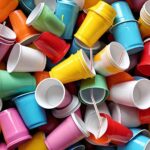
Thank you for reading, for more interesting articles please visit our homepage.

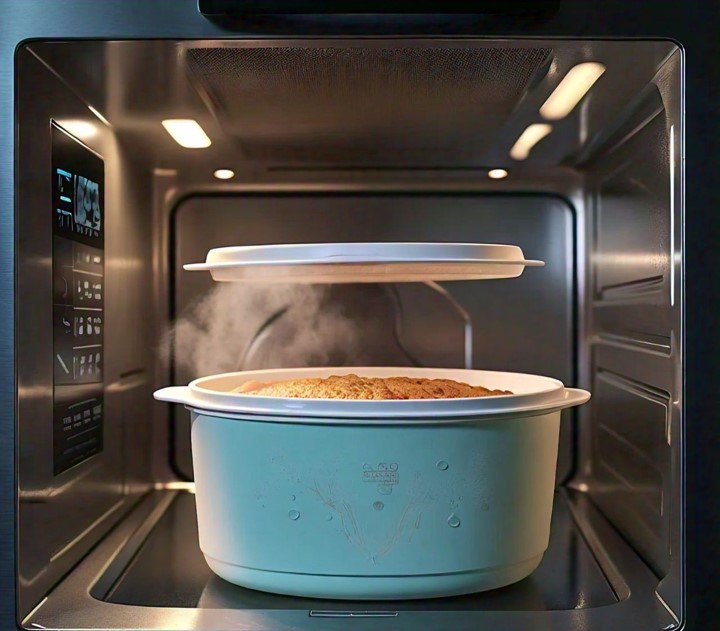

Pingback: Everything You Need to Know About Plastic Cups